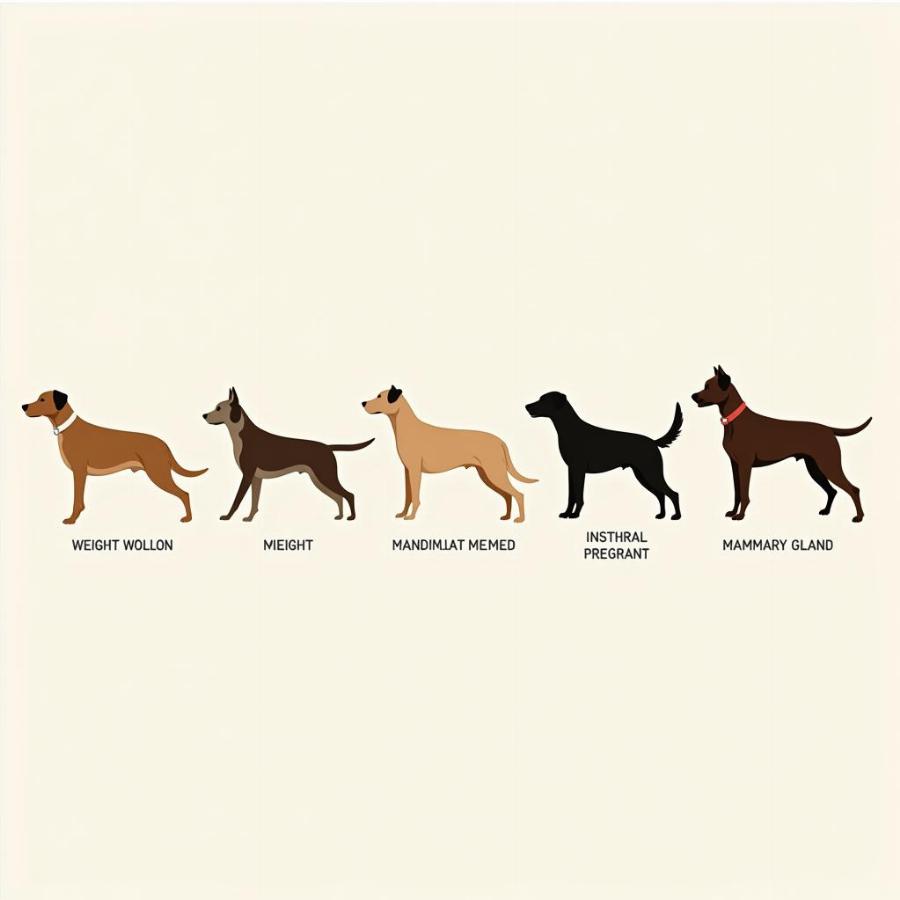Welcoming a litter of puppies into the world is an exciting time for any dog owner. A dog gestation calendar can be an invaluable tool to help you prepare for the arrival of those adorable fur babies. Knowing the timeline of your dog’s pregnancy allows you to provide the best possible care for the mother-to-be and ensures you are fully prepared for the big day.
Understanding the Basics of Dog Pregnancy
The average gestation period for dogs is about 63 days, or roughly nine weeks, from the date of conception. However, it’s essential to remember that this is just an average. Just like in humans, the exact length of pregnancy can vary slightly depending on factors such as breed size, the mother’s age, and individual health.
 Dog Pregnancy Stages Illustration
Dog Pregnancy Stages Illustration
Week by Week Breakdown: Your Dog’s Gestation Calendar
To help you better understand what to expect at each stage, let’s break down a typical dog pregnancy week by week:
Week 1: During the first week, fertilization occurs, and the embryos begin to implant in the uterine lining. You won’t notice any visible changes in your dog yet.
Week 2: Hormonal changes begin to take place. Some dogs may experience mild morning sickness or a slight decrease in appetite.
Week 3: The embryos develop into fetuses, and your veterinarian can detect their heartbeats via ultrasound. This is also when you might notice subtle changes in your dog’s nipple size and color.
Week 4: The fetuses start to develop more rapidly, and your dog’s appetite will likely increase. It’s important to start transitioning her to a higher-calorie, nutrient-rich diet to support the growing puppies.
Week 5: You’ll notice a more pronounced increase in your dog’s belly size. This is a good time to schedule a check-up with your veterinarian to monitor her progress and address any concerns.
Week 6: The puppies’ bones begin to harden, and your dog might start nesting, exhibiting behaviors such as gathering blankets or toys in a secluded area.
Week 7: The puppies are now considered fully developed. Your dog might seem restless or uncomfortable as her belly reaches its maximum size.
Week 8: Your dog’s body starts preparing for labor. You might notice a slight drop in her body temperature, and she may begin producing milk.
Week 9: This is the final stretch! Be prepared for labor to begin anytime now. Familiarize yourself with the signs of labor and have your veterinarian’s contact information readily available.
Signs of Labor: What to Expect When Your Dog is Expecting
As the big day approaches, it’s crucial to be aware of the signs that indicate labor is imminent. These signs include:
- Nesting behavior: As mentioned earlier, your dog might start gathering blankets or toys to create a comfortable space for delivery.
- Loss of appetite: Your dog may lose her appetite completely or show significantly reduced interest in food in the hours leading up to labor.
- Panting and pacing: Restlessness, pacing, and excessive panting are common signs that labor is near.
- Temperature drop: A slight decrease in your dog’s rectal temperature is a reliable indicator that labor will begin within 24 hours.
- Discharge: You might notice a clear, watery discharge from your dog’s vulva.
Essential Tips for a Smooth Pregnancy and Delivery
- Veterinary care: Regular veterinary checkups are crucial throughout your dog’s pregnancy. Your vet can monitor her health, address any concerns, and ensure a safe delivery.
- Nutrition: Provide your pregnant dog with a high-quality, balanced diet specifically formulated for pregnant or lactating dogs.
- Exercise: Moderate exercise is essential, but avoid strenuous activities that could harm the developing puppies.
- Prepare a whelping box: Create a comfortable, safe, and easily cleanable space where your dog can give birth and care for her puppies.
FAQs: Common Questions About Dog Pregnancy
Q: How can I tell if my dog is pregnant?
A: While some early signs like increased appetite and nipple changes can indicate pregnancy, the most reliable way to confirm is through a veterinary examination and possibly an ultrasound.
Q: Can I be present during the birth?
A: Some dogs prefer to have their owners present during labor for comfort and reassurance. However, others might feel stressed by your presence. It’s best to gauge your dog’s comfort level and respect her space if needed.
Q: When should I call the vet during labor?
A: It’s best to stay in close communication with your veterinarian throughout the labor process. Call immediately if you notice any complications, such as prolonged labor, excessive bleeding, or if you have any concerns about the mother’s or puppies’ well-being.
For a Pawsitive Pregnancy Experience
Navigating your dog’s pregnancy journey is an exciting and rewarding experience. By understanding the timeline, recognizing the signs of labor, and providing proper care, you can ensure a healthy pregnancy and a smooth delivery for your beloved furry friend. Remember, knowledge is power, and a little preparation goes a long way in ensuring a positive outcome for both the mother dog and her adorable puppies.
For more helpful tips and guidance on caring for your pregnant dog, check out our other articles on [puppy care](link to relevant article) and [dog nutrition](link to relevant article).
Beaut Dogs: Your Trusted Source for All Things Canine
Beaut Dogs is your one-stop resource for all things dog-related. We are dedicated to providing dog owners and enthusiasts with accurate, insightful, and engaging content to help you provide the best possible care for your furry companions. From breed information to health advice, training tips, and more, we’ve got you covered.
For personalized support and expert advice, don’t hesitate to reach out to our team at [email protected]. We’re here to help you navigate every step of the way!